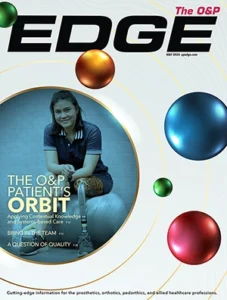From: Skewes, Ed
Sent: Wednesday, June 05, 2013 5:22 PM
To: ‘Orthotics and Prosthetics List
Subject: residency project ideas – summary of responses
1) Have you seen the stance control/RGO cases that Joanne Kanas has done up in Philly?
I have worked with her on several cases with good success.
Might be a good project.
Regards,
GaryB Becker Orthopedic (650) 349-0752
2) I would like to see a project that rates the dynamic stability of prosthetic knees. We are all taught in school that polycentric knee are the most inherently stable and that single axis knees are the least stable, but we know that is not true when factoring in other stance controlling mechanisms such as friction brakes, hydraulic, pneumatic, and electronic stabilizers. The real value of stability should be rated when the knee is flexed and loaded. The recovery time a knee allows when a misstep occurs is what I call dynamic stability. The rate at which a loaded knee collapses is crucial to safety, especially for at risk populations.
3) Many time knees with such sabilizing features are classified as K3 functional level devices. I believe that the people who could best benefit from more dynamically stable knees are persons rated at K2 functional levels, making such a project significant. Jim.
James O. Young Jr., LP, CP, FAAOP
Amputee Prosthetic Clinic Macon, Tifton, Albany 888FAKELEG 888fakeleg.com
4) As the Project Manager for the Seattle Foot, the original, or modern version of the energy storing foot, I recommend they start with something that interests them, what would that be?
5) Ed, how about a simple study on whether boston brace straps stretch? I always tell my patients that the straps don’t stretch, but I don’t know it as a fact.
Bob Jensen CPO
6) Ed, Does your department do much in the way of twister cables for tibial torsion?
I know it is old technology, but I have developed a new goniometer to measure foot progression angle and did a full literature search on the topic.
The goniometer in essence replaces the NYU/Lehneis device.
Could be a topic with the twister cables or with Dennis Browne bar type of devices as well.
Regards, GaryB
7) Hi Ed,
I hope all is well with you. My pet peeve is why haven’t we as a field, not attempted to develop some type of weight recommendations for Orthotic Component sidebars, bands etc. I realize that mfg. Knee and Ankle components vary but does anyone really understand the strength difference between Aluminum 5/8″x 3/16″ sidebars vs. the same size in SS (or Titanium)? Sure would be a helpful when correctly designing your KAFO devices to fashion the safest possible device w/o the risk of failure….
Enjoy the weekend!
John F. Schulte
8) Dear Edward
I am one of the owners of JMMR Inc . We make a the Simplicity System KAFO for the treatment of Blounts disease . I would like to suggest a study on the current available KAFOs for the treatment of Blounts. We would be happy to give you assistance in this study.
Please let me know if this is a good subject for your residency program. Sincerely Michael Rebarber CO,LPO JMMR Inc 579 Goffle Rd Wyckoff, NJ 07481 800 236 5166
9) Effects of NMES regarding pediatric gait. Compare AFO vs Walkaid
10) Simple shoe problems instead of custom inserts, Sent from my iPod
11) Good morning Edward, How about neural correlation in physical rehabilitation. Attached is a white paper to this effect.
Michael Wilson cpo
The Biology of Physical Restoration
And Rehabilitation Science
By Michael Wilson CPO/LP FAAOP BS
13)
Dear Ed,
Hopefully you have some ongoing research. I have just added our current resident to an IRB so she can start creating some preliminary results.
Pilot studies are great. You have to submit an IRB application immediately to be able to do something. For instance, we had one resident take one CP kid through the gait lab for several passes while trimming back the PLS-AFO to lesser and lesser stiffness in an attempt to approximate the gait with an articulated AFO.
Strength of materials testing can be done without an IRB.
Retrospective chart reviews require an IRB, but can be useful. You have plenty of charts available. Do you know what your overall success rate with nocturnal scoliosis management is? A resident could find that for you.
A resident can start an ongoing research project. One of ours a few years ago started a project that is ongoing comparing fibular hemimelia outcomes between Ilizarov reconstruction and amputation. (The results favor amputation.)
Sincerely,
Kevin Felton, CO, LO, FAAOP
Education Coordinator, Orthotics Department Texas Scottish Rite Hospital for Children
2222 Welborn Street
Dallas, TX 75219-3883
voice: 214-559-7440
fax: 214-559-7473
website: www.tsrhc.org
email: [email protected]
CONFIDENTIALITY NOTICE: This e-mail communication and any attachments may contain confidential and privileged information for the use of the designated recipients. If you are not the intended recipient, (or authorized to receive for the recipient) you are hereby notified that you have received this communication in error and that any review, disclosure, dissemination, distribution or copying of it or its contents is prohibited. If you have received this communication in error, please destroy all copies of this communication and any attachments and contact the sender by reply e-mail or telephone (813) 281-0300.




